Abstract
1. A monoclonal antibody (subclass immunoglobulin G1) has been raised against human brain-type creatine kinase (CK-BB). This antibody did not cross-react with either muscle-type creatine kinase (CK-MM) or heart-type creatine kinase (CK-MB). 2. The binding constant measured with native antibody was 6 X 10(8) M-1. In the presence of 2mM-dithiothreitol this constant was some 40-50-fold greater. 3. Partial reduction and alkylation showed that the increased binding was due to a direct effect on the antibody and was associated with concomitant cleavage of the heavy-heavy interchain disulphide bonds. The binding constant measured with Fab' fragments produced from reduced and alkylated antibody was similar to that shown by the native, unreduced antibody. 4. The molecular weight of the complex found in the absence of mercaptans was consistent with one antibody and one CK-BB molecule, whereas the molecular weight estimated with reduced and alkylated antibody was consistent with a complex of two antibodies and two CK-BB molecules. 5. It is proposed that mercaptans increase the flexibility of the hinge region of the antibody molecule, allowing the formation of a higher-order complex with increased avidity for the CK-BB dimer.
Full text
PDF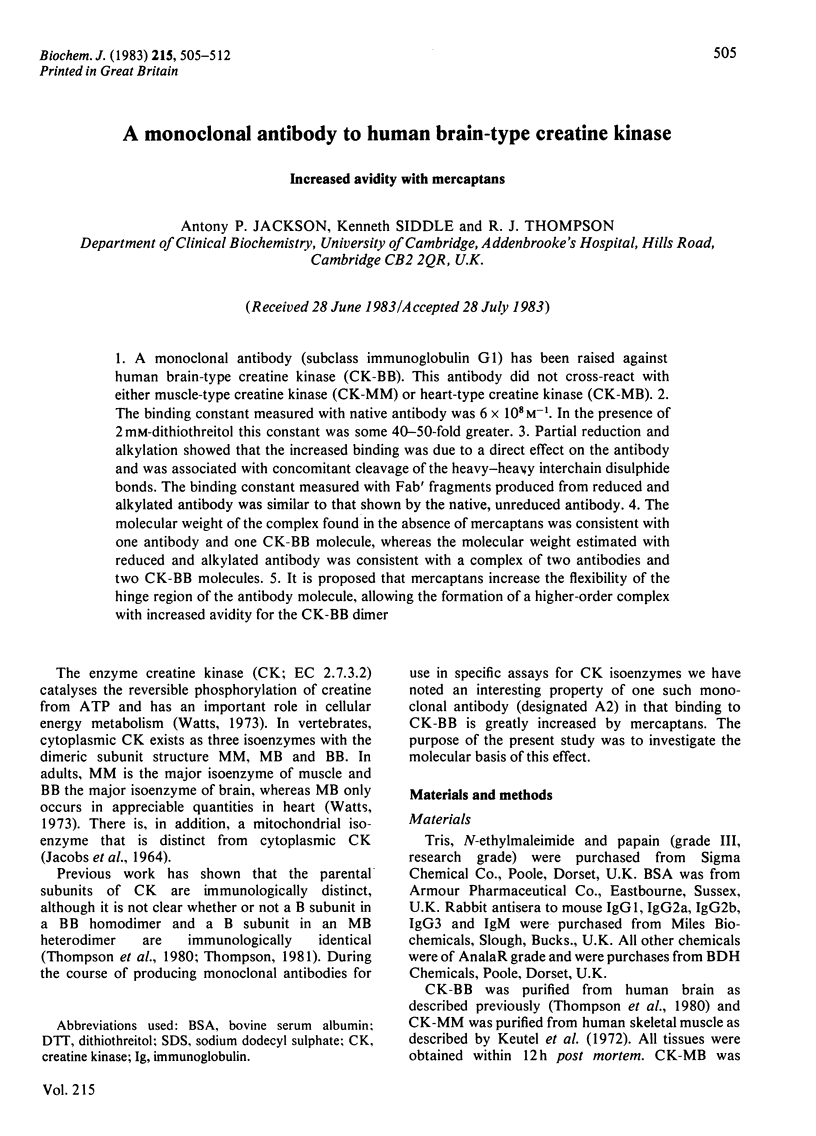
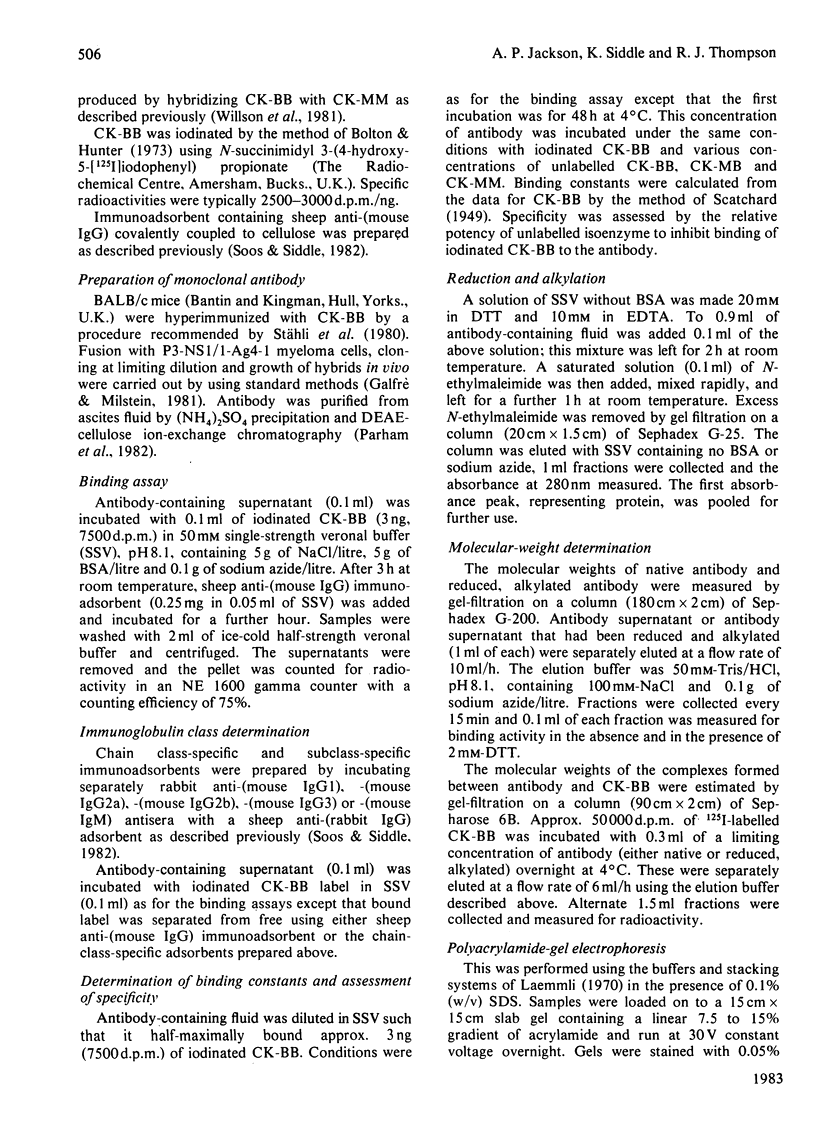
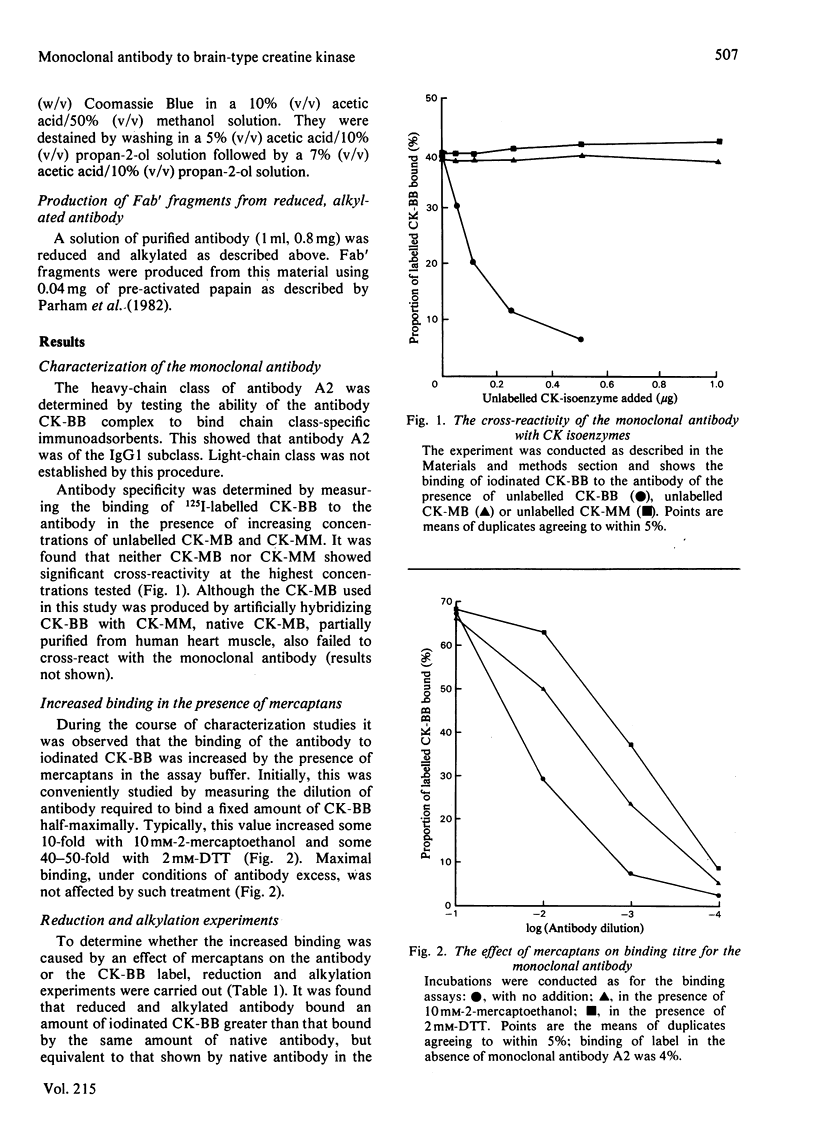
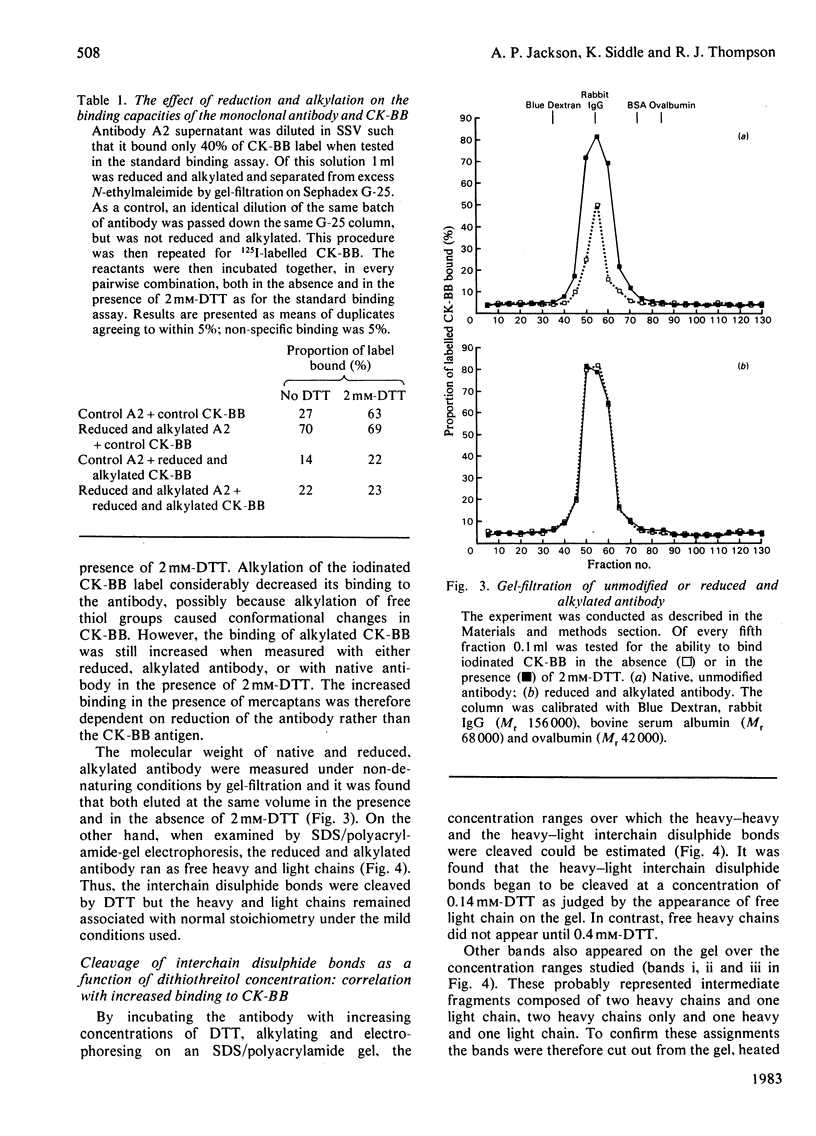
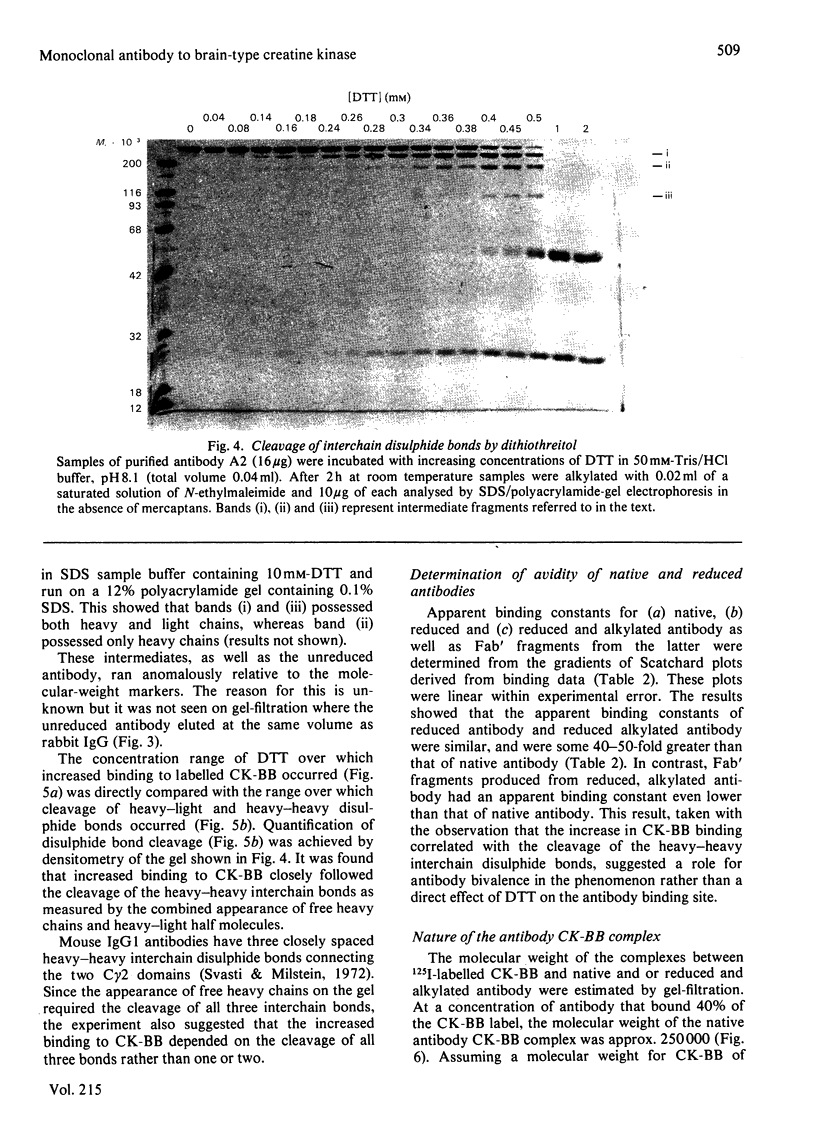


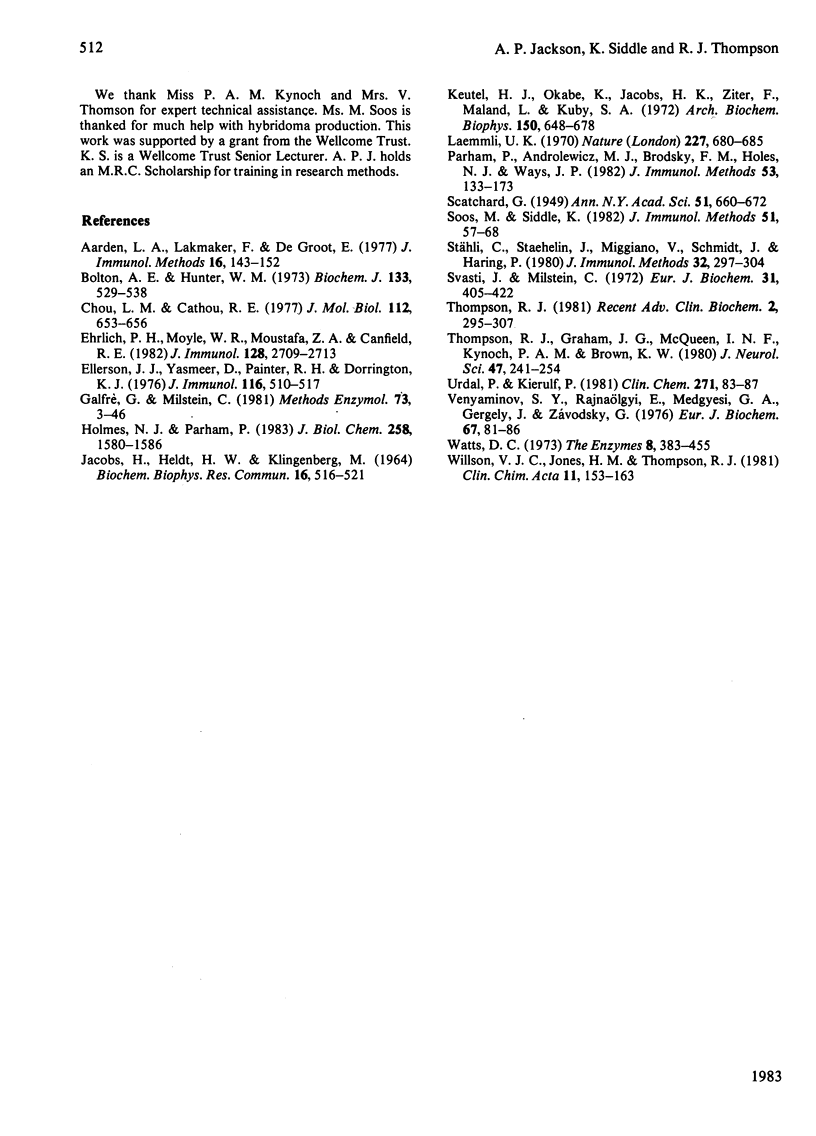
Images in this article
Selected References
These references are in PubMed. This may not be the complete list of references from this article.
- Aarden L. A., Lakmaker F., De Groot E. Immunology of DNA. VI. The effect of mercaptans on IgG and IgM anti-dsDNA. J Immunol Methods. 1977;16(2):143–152. doi: 10.1016/0022-1759(77)90049-7. [DOI] [PubMed] [Google Scholar]
- Bolton A. E., Hunter W. M. The labelling of proteins to high specific radioactivities by conjugation to a 125I-containing acylating agent. Biochem J. 1973 Jul;133(3):529–539. doi: 10.1042/bj1330529. [DOI] [PMC free article] [PubMed] [Google Scholar]
- Chan L. M., Cathou R. E. The role of the inter-heavy chain disulfide bond in modulating the flexibility of immunoglobulin G antibody. J Mol Biol. 1977 Jun 5;112(4):653–656. doi: 10.1016/s0022-2836(77)80170-8. [DOI] [PubMed] [Google Scholar]
- Ehrlich P. H., Moyle W. R., Moustafa Z. A., Canfield R. E. Mixing two monoclonal antibodies yields enhanced affinity for antigen. J Immunol. 1982 Jun;128(6):2709–2713. [PubMed] [Google Scholar]
- Ellerson J. R., Yasmeen D., Painter R. H., Dorrington K. J. Structure and function of immunoglobulin domains. III. Isolation and characterization of a fragment corresponding to the Cgamma2 homology region of human immunoglobin G1. J Immunol. 1976 Feb;116(2):510–517. [PubMed] [Google Scholar]
- Galfrè G., Milstein C. Preparation of monoclonal antibodies: strategies and procedures. Methods Enzymol. 1981;73(Pt B):3–46. doi: 10.1016/0076-6879(81)73054-4. [DOI] [PubMed] [Google Scholar]
- Holmes N. J., Parham P. Enhancement of monoclonal antibodies against HLA-A2 is due to antibody bivalency. J Biol Chem. 1983 Feb 10;258(3):1580–1586. [PubMed] [Google Scholar]
- Jacobs H., Heldt H. W., Klingenberg M. High activity of creatine kinase in mitochondria from muscle and brain and evidence for a separate mitochondrial isoenzyme of creatine kinase. Biochem Biophys Res Commun. 1964 Aug 11;16(6):516–521. doi: 10.1016/0006-291x(64)90185-8. [DOI] [PubMed] [Google Scholar]
- Keutel H. J., Okabe K., Jacobs H. K., Ziter F., Maland L., Kuby S. A. Studies on adenosine triphosphate transphosphorylases. XI. Isolation of the crystalline adenosine triphosphate-creatine transphosphorylases from the muscle and brain of man, calf, and rabbit; and a preparation of their enzymatically active hybrids. Arch Biochem Biophys. 1972 Jun;150(2):648–678. doi: 10.1016/0003-9861(72)90085-9. [DOI] [PubMed] [Google Scholar]
- Laemmli U. K. Cleavage of structural proteins during the assembly of the head of bacteriophage T4. Nature. 1970 Aug 15;227(5259):680–685. doi: 10.1038/227680a0. [DOI] [PubMed] [Google Scholar]
- Parham P., Androlewicz M. J., Brodsky F. M., Holmes N. J., Ways J. P. Monoclonal antibodies: purification, fragmentation and application to structural and functional studies of class I MHC antigens. J Immunol Methods. 1982 Sep 17;53(2):133–173. doi: 10.1016/0022-1759(82)90137-5. [DOI] [PubMed] [Google Scholar]
- Soos M., Siddle K. Characterization of monoclonal antibodies directed against human thyroid stimulating hormone. J Immunol Methods. 1982;51(1):57–68. doi: 10.1016/0022-1759(82)90382-9. [DOI] [PubMed] [Google Scholar]
- Stähli C., Staehelin T., Miggiano V., Schmidt J., Häring P. High frequencies of antigen-specific hybridomas: dependence on immunization parameters and prediction by spleen cell analysis. J Immunol Methods. 1980;32(3):297–304. doi: 10.1016/0022-1759(80)90194-5. [DOI] [PubMed] [Google Scholar]
- Svasti J., Milstein C. The parallel nature of the interchain disulphide bonds of immunoglobulins. Studies on a mouse IgG1 myeloma protein. Eur J Biochem. 1972 Dec 18;31(3):405–422. doi: 10.1111/j.1432-1033.1972.tb02547.x. [DOI] [PubMed] [Google Scholar]
- Thompson R. J., Graham J. G., McQueen I. N., Kynoch P. A., Brown K. W. Radioimmunoassay of brain-type creatine kinase-BB isoenzyme in human tissues and in serum of patients with neurological disorders. J Neurol Sci. 1980 Aug;47(2):241–254. doi: 10.1016/0022-510x(80)90008-8. [DOI] [PubMed] [Google Scholar]
- Urdal P., Kierulf P. Sensitive and specific radioimmunoassay for creatine kinase BB isoenzyme in serum, with use of an autoantibody. Clin Chem. 1981 Jan;27(1):83–87. [PubMed] [Google Scholar]
- Venyaminov S. Y., Rajnavölgyi E., Medgyesi G. A., Gergely J., Závodszky P. The role of interchain disulphide bridges in the conformational stability of human immunoglobulin G1 subclass. Hydrogen-deuterium exchange studies. Eur J Biochem. 1976 Aug 1;67(1):81–86. doi: 10.1111/j.1432-1033.1976.tb10635.x. [DOI] [PubMed] [Google Scholar]
- Willson V. J., Jones H. M., Thompson R. J. A two-site immunoradiometric assay for the MB isoenzyme of creatine kinase. Clin Chim Acta. 1981 Jun 18;113(2):153–163. doi: 10.1016/0009-8981(81)90149-2. [DOI] [PubMed] [Google Scholar]



